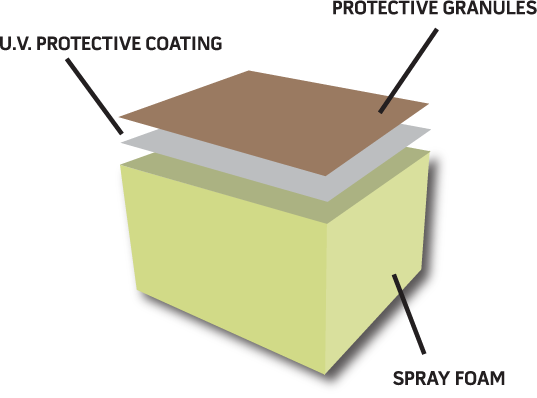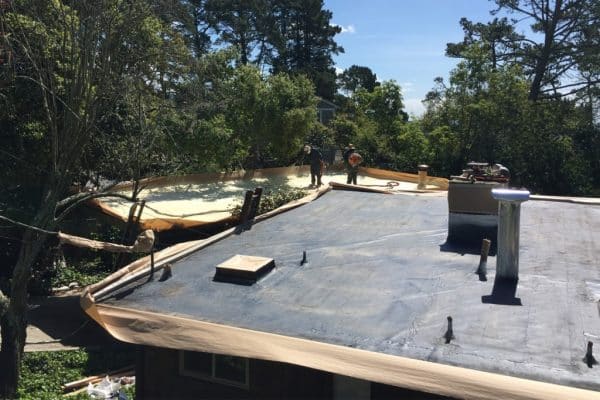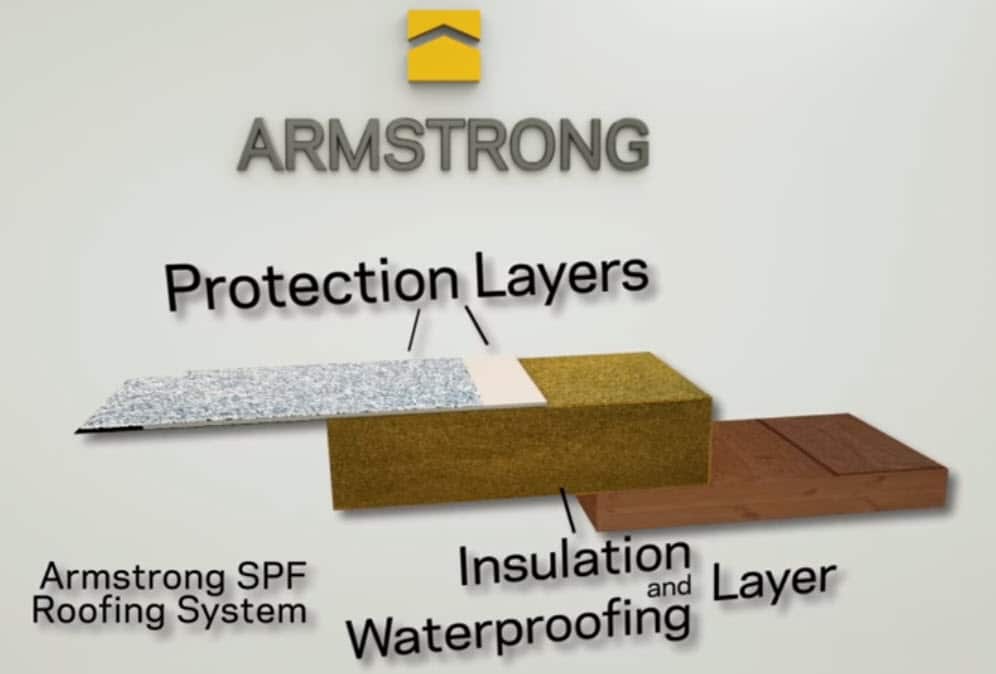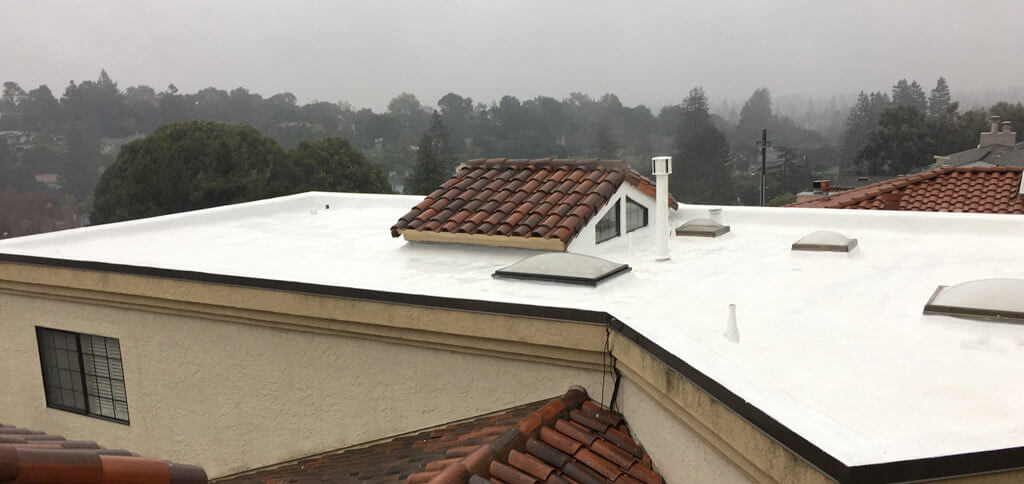If you’re looking for a durable and high-performing roofing material for your residential or commercial property, look no further than spray polyurethane foam (SPF), most commonly referred to as foam roofing. With its exceptional insulative and waterproofing properties, SPF is the ultimate solution for boosting energy efficiency and enhancing interior comfort. In fact, no other roofing material can quite match the longevity and performance of an SPF roofing system.
In this article, we will explore what spray foam roofing is, its installation process, maintenance tips, the benefits of installing it compared to conventional built-up roofing systems like tar and gravel and its cost.
What is Spray Foam Roofing?
Spray foam roofing is a type of roofing system that involves spraying a polyurethane foam layer of 1 ½” + or – ¼ ″ thickness onto your roof substrate. The spray foam creates a seamless monolithic barrier, that is both water-proofing and insulating.

This layer is then covered with a protective coating, which can be made from a variety of materials, including acrylics, silicone, or polyureas. The protective coating can be anywhere from 10-30 mils thick. The coating consists of 2 coats of elastomeric AWS ultraviolet protective coating. To safeguard your newly installed foam roof, it’s crucial to apply the UV coating because, without it, the sun’s radiation can quickly damage the foam and compromise your roof’s integrity. As a final step, a sturdy layer of ceramic granules is added to the elastomeric coating. This infusion creates a seamless, impenetrable waterproof barrier that can withstand harsh weather conditions and provide long-lasting protection.
The Foam
Armstrong’s spray foam roofing systems are made from closed-cell foam because it is designed to provide energy efficiency and durability. The cells in closed-cell foam are tightly packed so that air and moisture cannot penetrate it. This also makes it more rigid and stable than open-cell foam. As a result, it is used as a part of a complete roofing system and is an ideal option for both new construction and existing roofing.
Closed-cell foam provides excellent thermal performance and can help reduce heating and cooling costs. It is lightweight, offers superior protection from the elements, and can be easily installed by experienced professional foam roofing contractors like Armstrong Foam Roofing. Additionally, it is highly fire-resistant and provides excellent soundproofing capabilities. Closed-cell foam is a great choice for both commercial and residential roofing applications and can provide a lifetime of protection.
The foam density used by Armstrong Foam Roofing is rated at 3LB which means that our roofs have the highest quality roofing foam available today and that it is rigid enough for you to walk on. The 3LB foam used offers high insulation values, strength, and exceptional longevity.
The Foam Roofing Installation Process
Armstrong’s 10-step foam roofing installation process means that every roofing system is installed properly and under the correct conditions so that it can last a lifetime. We are so confident in our installation process that we offer all our roofing clients the most comprehensive warranties in the SPF roofing industry.

Armstrong Foam Roofing ensures precision in our roofing services by conducting a comprehensive on-site survey using satellite technology. Before any foam roofing work is initiated, an Armstrong Installation Department Technician conducts a pre-site inspection to assess the required preparation prior to spraying. What’s more, we assist our clients by obtaining all the necessary job-related permits, with the cost reimbursed later on.
Basics of the Installation Process
Spray foam roofing installation usually involves the following steps:
- Preparation: The roof surface is cleaned and any damaged areas are repaired before the foam is applied to your roofing substrate. Our foam roofing crews also take great care in protecting surrounding structures and properties during the preparation process to avoid exposure to foam overspray.
- Application of Foam: The foam is sprayed onto the roof surface using a spray gun. The foam then expands up to 30 times its original volume to fill any cracks, gaps or crevices, and creates a seamless insulation layer sealing effectively around difficult roof features such as skylight windows or circular exhaust vents.
- Protective Elastomeric Coating: Once the foam layer is in place, two layers of a protective coating are applied over the top. Then durable granules are added to help avoid UV, rain, and wind damage. The protective coating acts as a shield against the elements so your roof can perform like new for approximately another 20 years.

Maintenance Tips
Spray foam roofing is low-maintenance, but there are a few things you can do to keep it in good condition:
- You should keep your spray foam roofs clean of debris and standing water to avoid damage to the protective coating. This means that you should check and clean drains, outlets, and gutters a minimum of twice a year to ensure debris has not backed up and allowed water to flow in the wrong direction. Even though foam roofs can hold some standing water without any damage to your roofing system, it is always a good idea to make sure the water is flowing off the roof as it should.
- Check for damages from tree branches or for cracks or holes in the protective coating, especially after extreme weather events. Fortunately, due to Armstrong foam roofing’s exceptional water protective qualities, a branch would need to completely puncture, through to the substrate for water to infiltrate the living space which is something quite rare. If you do notice any damage, it should be repaired immediately to prevent further damage.
- Schedule regular inspections in the spring and fall. These inspections are important especially if you have skylights which can be vulnerable to potential weather incursions or if you have foot traffic from technicians who service your HVAC or other equipment you may have on your foam roof. By inspecting your roof, you can identify any issues early which can help you avoid costly repairs down the line.
- Recoat your foam roofing every 15-20 years to continue to preserve and protect it against the elements and extend its lifespan. Over the years, weather conditions and the sun’s UV rays begin to break down the protective layers of elastomeric coating which must be reapplied to prevent the UV rays from degrading the polyurethane foam. If your foam roofing is left unprotected, it can degrade at the rate of about 1/16” per year. However, in order for your foam roof to completely fail, it must be left unprotected and neglected for many years since the thickness of an SPF roofing system can range from 1” to 3” in thickness.
Benefits of Spray Foam Roofing
There are numerous significant benefits to using spray foam roofing compared to conventional built-up roofing like tar and gravel. Here are just a few:
Energy Efficiency
Spray foam roofing provides excellent insulation, which can help reduce heating and cooling costs. It is over 500% more efficient than conventional roofs and can pay for its cost within 3 to 4 years. Foam roofing is also recommended by the Energy Department as it is a long-lasting ultra-light insulating foam that will keep your home cool during summer and prevent the heat from escaping in winter.
Durability
Spray foam roofing is durable and long-lasting. It can withstand extreme temperatures, high winds, and heavy rainfall, and provide superior hail and impact absorption. Even if a wind-driven missile damages the roof, it will rarely cause a leak and the damage can be easily repaired without compromising its performance.
Seamless Design
Spray foam roofing creates a seamless insulation layer that is more resistant to leaks than traditional roofing systems. The monolithic layer of foam eliminates the expansion and contraction that can affect traditional multi-layered roofing systems which separate and allow water and microbes to seep in and damage your roof. Foam roofing also eliminates roof leaks caused by faulty flashing because the foam conforms to any substrate when installed. This makes it ideal for flashing parapet walls, equipment, skylights, and cooling towers.
Reduced Environmental Impact and Sustainability
Spray foam roofing is a more eco-friendly option than traditional roofing systems and is an excellent option that can provide your home with long-lasting protection. By ensuring proper installation and maintenance, your foam roofing system can serve you for a lifetime. To maintain its peak performance, you only need to recoat it every 20 years or so.
One of the great benefits of foam roofing is that it eliminates the need for expensive roof tear-offs and the resulting waste that ends up in landfills. This is because foam can easily adhere to most materials, making it possible to install it with minimal stripping of the original roof. This not only saves you time and money but also makes foam roofing an environmentally-friendly choice.
Additional Benefits
In addition to the main benefits mentioned above, foam roofing also has the following unique benefits that will provide extra protection for your residential or commercial property:
✅ Provides excellent seal and insulation for ductwork or any other rooftop installations
✅ It’s Ideal for unusual roof shapes or designs
✅ It can protect multiple roof-level connections
✅ Minimizes the stress on your home’s building envelope since it’s extremely lightweight
The Cost of Foam Roofing
The actual cost of your foam roof can vary depending on several factors such as the cost of materials and labor, the size of your roof, and the complexity of the installation. Generally speaking, as we have mentioned, foam roofing is considered to be a cost-effective option in the long run due to its durability and energy efficiency.
While the upfront cost of SPF roofing may be slightly higher compared to other roofing materials, it can last for decades with proper installation and maintenance. It can provide significant energy savings over time by helping to regulate the temperature of your home and reducing the need for heating and cooling systems. As we have already mentioned, the energy savings from foam roofing can pay for its cost within 3 to 4 years. What’s more, with proper installation and maintenance, your spray foam roofing system can protect your home for a lifetime. You only have to recoat it every 20 years to ensure it keeps performing like new.
Additionally, foam roofing can eliminate the need for costly tear-offs and replacements, making it a more environmentally friendly option. It’s always a good idea to consult with a licensed and experienced roofing contractor like Armstrong Foam Roofing to get an accurate estimate for the cost of your foam roofing. Our roofing consultants can provide you with a detailed breakdown of the costs and help you make an informed decision about whether foam roofing is the right choice for you.
Choose the Best Foam Roofing Contractor in the San Francisco Bay Area
Recognizing the value of foam roofing, and the fact it has proven to be more durable and affordable than tar and gravel roofing, foam roofing has become very popular among northern California homeowners. However, there are few foam roofing contractors in the San Francisco Bay Area who can match Armstrong Foam Roofing in terms of experience and performance. We have more than 40 years of experience in installing foam roofing systems! We are also proud to claim that we have installed more residential foam roofing than any other company in America.
You must keep in mind that your foam roofing system will only be as good as the individuals who apply it. Consequently, you should contact professional local contractors with years of proven expertise and a high degree of technical knowledge. At Armstrong Foam Roofing, we are so confident of the quality of our foam roofing systems that we offer our customers some of the best and longest-lasting warranties available!
Only trust the best, that’s why you should contact the experts at Armstrong Foam Roofing. We offer a free no-obligation Satellite Roof Estimate and you can also arrange a remote free consultation. To find out more about our foam roofing systems and our installation process, contact Armstrong Foam Roofing today either by phone at 1-887-777-1234, via computer, Skype, or by email. Along with all the virtual ways we are providing estimates, we also offer at-home (outside) estimates for your convenience.

